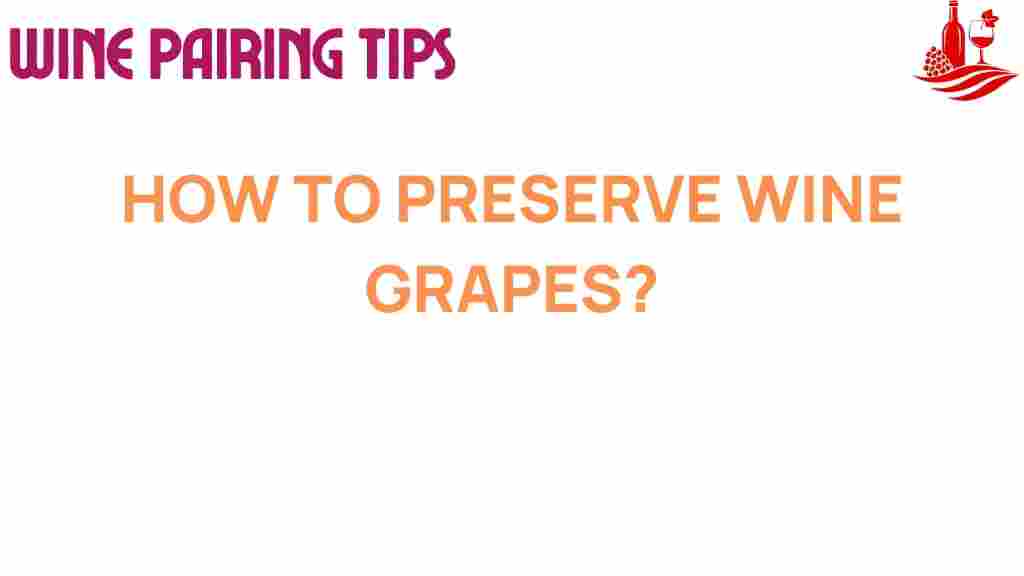Unlocking the Secrets: How to Preserve Wine Grapes
Wine grapes are the heart and soul of winemaking, and preserving them for longevity is essential for both amateur vintners and professional winemakers. Properly preserving wine grapes ensures that you can enjoy their flavors and qualities long after the harvest. In this article, we will explore various methods to preserve wine grapes, delve into different grape varieties, and provide essential winemaking tips. Additionally, we will discuss sustainable practices in vineyard management and how they contribute to effective grape preservation.
Understanding Grape Varieties
Before diving into the preservation methods, it’s crucial to understand the different types of grape varieties that are commonly used in winemaking. Each variety has its unique characteristics, which influence how they should be stored and preserved. Here are some popular grape varieties:
- Cabernet Sauvignon: Known for its deep color and full-bodied flavor, this grape is ideal for aging.
- Chardonnay: A versatile white grape that can be enjoyed young or aged for complexity.
- Merlot: Soft and fruity, this variety is often blended but can also stand alone.
- Pinot Noir: A delicate grape that requires careful handling and preservation techniques.
- Sauvignon Blanc: Crisp and refreshing, it is best enjoyed when preserved properly to maintain its acidity.
Preservation Techniques for Wine Grapes
To ensure that your wine grapes remain fresh and flavorful, consider the following preservation techniques:
1. Proper Harvest Timing
Harvesting grapes at the right time is critical for preservation. Grapes should be picked when they reach optimal ripeness, as this factors into their longevity during storage. Look for:
- Balanced sugar and acidity levels.
- Full color development.
- Aromas indicating peak flavor.
2. Handling and Transportation
Once harvested, handling grapes with care is essential. Here are some tips:
- Use clean, food-safe containers to avoid contamination.
- Avoid crushing or bruising the grapes during transportation.
- Transport grapes in a cool, shaded environment to prevent premature fermentation.
3. Optimal Wine Storage Conditions
Proper storage conditions can significantly affect grape preservation. Consider the following:
- Temperature: Store wine grapes at a consistent temperature between 55°F and 65°F (13°C to 18°C).
- Humidity: Maintain humidity levels around 70% to prevent the grapes from drying out.
- Light: Keep grapes in a dark environment to prevent light exposure, which can degrade quality.
4. Grape Preservation Techniques
There are several methods to preserve wine grapes effectively:
- Refrigeration: Storing grapes in a refrigerator can slow down the aging process.
- Freezing: If you have excess grapes, freezing can be a great option. Use airtight bags and remove as much air as possible.
- Dehydration: Drying grapes into raisins can concentrate their flavors and extend their shelf life.
- Fermentation: Initiating the fermentation process can also preserve the grapes by converting sugars into alcohol.
Winemaking Tips for Longevity
Once you have preserved your wine grapes, the next step is to ensure they are transformed into quality wine. Here are some winemaking tips to maintain the longevity of your wine:
1. Use Quality Equipment
Invest in good quality winemaking equipment to avoid contamination and ensure a clean process. Look for:
- Sanitizers to keep equipment clean.
- Quality fermentation vessels to manage the fermentation process.
- Temperature control systems for optimal fermentation conditions.
2. Monitor Fermentation
Keep a close eye on the fermentation process. Here are key points to consider:
- Check sugar levels regularly to determine when fermentation is complete.
- Maintain appropriate temperatures for the yeast to thrive.
- Monitor for any off-flavors or signs of spoilage.
3. Aging Your Wine
Proper aging can greatly influence the quality and longevity of your wine. Consider these factors:
- Barrel Aging: Using oak barrels can impart flavors and enhance complexity.
- Bottle Aging: Store bottles in a dark, cool place to allow the wine to mature.
- Monitor Aging: Taste your wine periodically to determine the optimal time for bottling.
Vineyard Management for Sustainable Practices
Practicing sustainable vineyard management can significantly impact grape preservation. Here are some strategies:
1. Organic Farming Practices
Using organic methods reduces chemical interventions, leading to healthier grapes. Benefits include:
- Improved soil health.
- Enhanced grape flavors.
- Reduced environmental impact.
2. Water Management
Implementing efficient irrigation systems helps conserve water while ensuring the vines receive the right amount of moisture.
3. Biodiversity
Encouraging biodiversity in your vineyard helps create a balanced ecosystem, reducing pests and diseases naturally. This can lead to healthier grapes and better preservation.
Troubleshooting Common Issues
Even with the best practices, issues may arise during grape preservation. Here are some common problems and solutions:
1. Mold Growth
If you notice mold on your grapes, it may be due to excess moisture. To prevent this:
- Ensure proper air circulation during storage.
- Keep humidity levels in check.
2. Premature Fermentation
Sometimes, grapes may start fermenting before you intend. To avoid this:
- Store grapes at lower temperatures immediately after harvest.
- Use sulfur dioxide to inhibit unwanted fermentation.
3. Loss of Flavor
If your grapes lose their flavor during storage, it may be due to improper conditions. To retain flavor:
- Regularly check storage conditions.
- Limit exposure to light and heat.
Conclusion
Preserving wine grapes is an art that combines knowledge of grape varieties, winemaking techniques, and sustainable vineyard management practices. By implementing the tips outlined in this article, you can effectively preserve wine grapes for longevity, ensuring that you enjoy the fruits of your labor for years to come. Whether you are an aspiring winemaker or a seasoned professional, understanding the intricacies of grape preservation can elevate your winemaking experience.
For more information on winemaking techniques and grape varieties, check out this comprehensive guide. Additionally, you can explore sustainable vineyard practices through resources available at sustainablewinemaking.org.
This article is in the category Tips and created by Wine Pairing Tips Team
